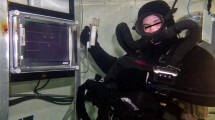Abstract
The objective of this article is to review the available studies regarding asthma and SCUBA (self-contained underwater breathing apparatus) diving. A literature search was conducted in MEDLINE to identify peer-reviewed articles related to asthma and SCUBA diving using the following keywords: asthma, allergy, and SCUBA diving. SCUBA diving is a popular sport with more than 9 million divers in the USA. SCUBA diving can be a dangerous sport. Bronchospasm can develop in asthmatic patients and cause airway obstruction. Airway obstruction may be localized to the distal airway which prevents gas elimination. Uncontrolled expansion of the distal airway may result in pulmonary barotrauma. There is also the risk of a gas embolism. Asthmatic divers can also aspirate seawater which may induce bronchospasm. Pollen contamination of their oxygen tank may exacerbate atopic asthma in patients. Diving may be hazardous to the lung function of patients with asthma. Despite the risks of SCUBA diving, many asthmatic individuals can dive without serious diving events. Diving evaluations for asthmatic patients have focused on a thorough patient history, spirometry, allergy testing, and bronchial challenges. For patients that wish to dive, their asthma should be well controlled without current chest symptoms. Patients should have a normal spirometry. Some diving societies recommend that an asthmatic patient should successfully pass a bronchial provocation challenge. Recommendations also state that exercise-, emotion-, and cold-induced asthmatics should not dive. Asthmatic patients requiring rescue medication within 48 h should not dive.

Similar content being viewed by others
References
Koehle M, Lloyd-Smith R, McKenzie D et al (2003) Asthma and recreational SCUBA diving: a systematic review. Sports Med 33(2):109–116
Wilmshurst P (1998) Diving and oxygen. BMJ 317(7164):996–999
Dear, G. Asthma and diving. Divers Alert Network. [Online] September 17, 2014. [Cited: September 16, 2014.] www.diversalertnetwork.org/medical/articles/Asthma_Diving
Neuman TS, Bove AA, O’Connor RD et al (1994) Asthma and diving. Ann Allerg 73(4):344–350
D’Amato G, Noschese P, Russo M et al (1999) Pollen asthma in the deep. J Allergy Clin Immunol 104(3 Pt 1):710
Astarita C, Gargano D, Di Martino P (2000) Pollen trapped in a scuba tank: a potential hazard for allergic divers. Ann Intern Med 132(2):166–167
Ivkovic D1, Markovic M, Todorovic BS (2012) Effect of a single pool dive on pulmonary function in asthmatic and non-asthmatic divers. Diving Hyperb Med 42(2):72–77
Skogstad M1, Thorsen E, Haldorsen T et al (2002) Lung function over six years among professional divers. Occup Environ Med 59(9):629–633
Cirillo I1, Vizzaccaro A, Crimi E (2003) Airway reactivity and diving in healthy and atopic subjects. Med Sci Sports Exerc 35(9):1493–1498
Weiss LD, Van Meter KW (1995) Cerebral air embolism in asthmatic scuba divers in a swimming pool. Chest 107(6):1653–1654
Tetzlaff K, Muth CM (2005) Demographics and respiratory illness prevalence of sport scuba divers. Int J Sports Med 26(7):607–610
Moon, Richard E. The case that asthmatics should not dive. Undersea and Hyperbaric Medical Society, Inc., 1995 pp. 45-80
Farrell PJ, Glanvill P (1990) Diving practices of scuba divers with asthma. BMJ 300(6718):166
Weaver LK1, Churchill SK, Hegewald MJ et al (2009) Prevalence of airway obstruction in recreational SCUBA divers. Wilderness Environ Med 20(2):125–128
Martini A1, Sbardella D, Bertini L (2012) Airway inflammation in professional divers: FeNO as a marker. Undersea Hyperb Med 39(5):901–907
Recommendations for standardized procedures for the on-line and off-line measurement of exhaled lower respiratory nitric oxide and nasal nitric oxide in adults and children-1999. This official statement of the American Thoracic Society was adopted by the ATS Board of Directors, July 1999. Am J Respir Crit Care Med. 1999 Dec; 160(6):2104-17
Anderson WJ1, Short PM, Williamson PA et al (2012) Inhaled corticosteroid dose response using domiciliary exhaled nitric oxide in persistent asthma: the FENOtype trial. Chest 142(6):1553–1561
Badier M1, Guillot C, Delpierre S et al (2000) Value of bronchial challenge in scuba diving candidates. J Asthma 37(8):661–665
Meehan C, Bennett M (2010) Medical assessment of fitness to dive—comparing a questionnaire and a medical interview-based approach. Diving Hyperb Med 40(3):119–124
Ong LM, Bennett MH, Thomas PS (2009) Pulmonary dysanapsis and diving assessments. Undersea Hyperb Med 36(5):375–380
Gorman D, Veal A (1995) SPUMS policy on asthma and fitness for diving. South Pacific Underwater Medicine Society, Melbourne
South Pacific Underwater Medicine Society. Suggested assessment for the diver with asthma. SPUMS. [Online] September 17, 2014. www.spums.org.au/public-file-download/full-spums-medical
Harrison D, Lloyd-Smith R, Khazei A et al (2005) Controversies in the medical clearance of recreational scuba divers: updates on asthma, diabetes mellitus, coronary artery disease, and patent foramen ovale. Curr Sports Med Rep 4(5):275–281
Walker RM. SPUMS annual scientific meeting 2006: are asthmatics fit to dive? Diving Hyperbaric Med, 2006, pp. 213-219
Committee, UK Sport Diving Medical. Asthma and diving. British Sub-Aqua Club. [Online] September 16, 2014. www.bsac.com/page.asp?section=1533§ionTitle=Respiratory+condition
Martin, L. Should asthmatics not SCUBA dive? Scuba diving explained, questions and answers on physiology and medical aspects of scuba diving . Flagstaff : Best Publishing Company, 1997, p. Section O
Corson KS. Risk assessment of asthma for decompression illness. Undersea Biomed Res. 1991, pp. 16-17
Bove AA, Davis, J. Bove and Davis’ diving medicine. 2004, pp. 441
Author information
Authors and Affiliations
Corresponding author
Additional information
The opinions or assertions herein are the private views of the authors and are not to be construed as reflecting the views of the Department of the Air Force or the Department of Defense.
Rights and permissions
About this article
Cite this article
Coop, C.A., Adams, K.E. & Webb, C.N. SCUBA Diving and Asthma: Clinical Recommendations and Safety. Clinic Rev Allerg Immunol 50, 18–22 (2016). https://doi.org/10.1007/s12016-015-8474-y
Published:
Issue Date:
DOI: https://doi.org/10.1007/s12016-015-8474-y




